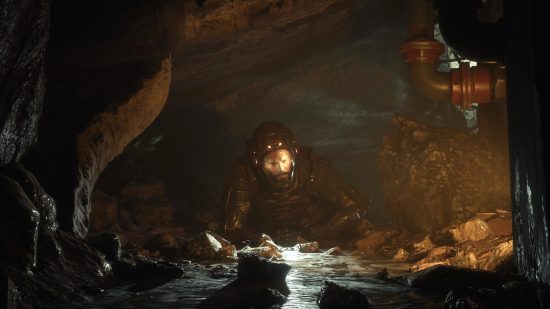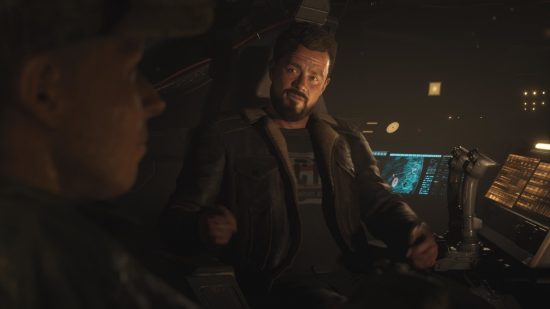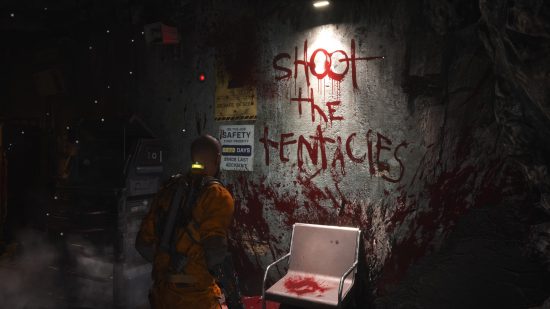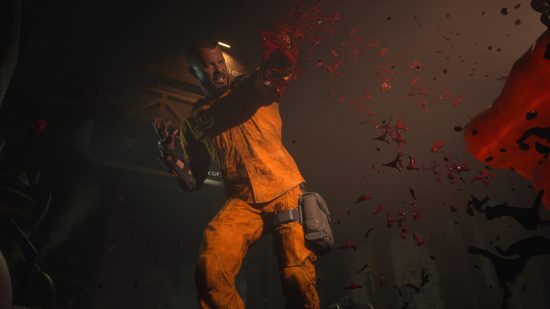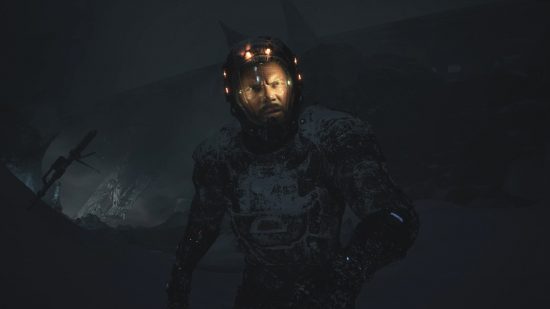Our Verdict
While not perfect, The Callisto Protocol is one of the best in its class, with jaw-dropping jump scares that’ll keep you up well into the night. With satisfying combat, incredible audio design, and jaw-dropping visuals, Striking Distance Studios has made a short but superb horror game that leaves you wanting more.
Everything is telling me not to go into that vent. The blood dripping from its edges, the slow thud of something moving up ahead, and the overwhelming feeling of dread that the last couple of hours has given me. But I know I have no choice: there’s no turning back here – the only way is forward.
My health bar is giving off a dim red glow and my hand cannon pistol- picked up from a dismembered guard – only has two rounds left. I should be paralysed with fear, but instead I’ve learned to push past my instincts and venture into the unknown of Black Iron Prison.
As I crawl my way around the corner, I can see the body of another prisoner lying ahead. I move forward to check on them, but as I do, their orange jumpsuit-clad body is dragged from view as a cacophony of noise floods the speakers. I hold my breath. There’s something in the vent with me. I know because the haptics in my PlayStation 5 controller is giving a small little kick on the left-hand side – exactly where that body was dragged to.

This is a familiar feeling in The Callisto Protocol, the debut game from Striking Distance Studios, and, as you can guess, it’s designed to get your heart racing. For those of you who’ve played Dead Space, the space horror lovingly created by Glen Schofield and Michael Condrey, you’ll be pleased to know that the former’s hands are all over this scary space adventure.
From the claustrophobic corridors, the immersive sound design, and the horror engineering, this is a game that looks and feels like Dead Space, with one main difference: The Callisto Protocol is ten times better.
This jump in quality comes largely down to the pacing of the game. While it can be slow in places, the pacing reminds you that Jacob Lee, the main protagonist, is human and approaches situations just like you or I would. This is made clear in the game’s introduction, where Jacob strolls down to the cargo hold to investigate a ship error without a care in the world, only to find the Outer Way Terrorist Group has breached the hull.
Before the breach, you’re introduced to the core controls, which largely consists of squeezing through narrow gaps, crouching, vaulting, and keeping quiet. Until things go wrong, of course, and then you’re going to need to run.
And go wrong they do. Within minutes of you investigating the hull, Jacob is forced into a heavy cumbersome sprint – something that you can physically feel through the haptics – and back into the bridge. But before he can quite make it, Dani Nakamura, the lead terrorist you see in the game’s opening sequence, fires a shot through the cockpit window, breaking the airlock and forcing you to claw your way back to your seat as the atmosphere tears the ship apart.
This is where the game’s first real blockbuster moment is shown and honestly, it’s breathtaking. When you go into a horror game, you go in with expectations that things will ramp up quite quickly, but The Callisto Protocol does this with such ease and grace that it captivated me right from the start. And this is coming from someone who traditionally cannot stand playing horror games.
After rolling credits on The Callisto Protocol ten hours on, I’ve come to the conclusion that it isn’t a traditional horror game that you’ll find on our best PS5 horror games or Xbox horror games lists. Like the biophages within it, The Callisto Protocol is an evolved version of horror that will long stand the test of time. Yes, there’s plenty of jumpscares and gore, but it pushes you to your limits without breaking your spirit – for the most part, anyway.
All this comes down to the work that the development team has put into its horror engineering – a system designed to ramp up the scares and make them more and more unpredictable. While lights will flicker and the music will change as you progress through the game’s many levels, it doesn’t always result in a fright. Take the vents for example; while I hate squirming through them because of what might be on the other side, I often navigate them safely. But when something did frighten me inside the vent, I quickly began searching for alternative routes.
It’s a clever system designed to keep you on your toes throughout and something that’s helped by the game’s magnificent environmental storytelling. As you explore Black Iron Prison and come face to face with the undead, you’ll discover things about Jupiter’s dead moon at the same time as Jacob. You’ll learn through the early messages written in red that newly freed inmates are out for blood. At the same time audio recordings and other messages will reveal the guards are frightened and have no clue what is going on.
As you descend further into the fortress, you’ll find evidence of people being dragged along the floor, up the walls, and into vents. Occasionally you’ll find a stray limb or two just to prove the point that what you’re fighting – whatever they are – won’t hold back.
To make matters worse, you’ll hear them creeping about the entire game. You might not necessarily see them, but trust me – they’re there and they’re always watching. Sometimes, as you move from room to room collecting resources, you’ll hear a crash and the distinctive noise of mutants running through the vent system above you. Sometimes they’ll show their ugly faces in a clattering of noise and other times, they’ll run from room to room, watching you as you follow their movement both in-game and through your controller.
The sound design in The Callisto Protocol is nothing short of incredible and it’s one of those games that you have to play with headphones. I’ve played with both surround sound and headphones and the latter feeds much more into the horror vibe, giving you more of an idea of the sheer amount of enemies surrounding you.
When it comes to actually facing your fears and fighting these creatures, that’s something that takes a little while to get used to. While the game does a great job of introducing you to combat and the weapons you find later down the line, the dodge system in particular feels a little clunky at first as you have to tilt the stick in alternating directions rather than press a button. But with every fight, you’re able to refine your skills and, over time, you can dodge an incoming blow with ease. The combat itself feels rewarding, largely because Jacob doesn’t feel like a full blown superhero. His lunges are hefty, but they have a cost in stamina, meaning you have to judge your combinations in order to take enemies down.
Every landed blow gives feedback in the PS5’s DualSense too, which makes fights feel more rewarding, especially as you land multiple hits. With weapons, your controller will shudder when you pull the trigger, yet again adding more realism and intensity to the world of horror.
Like the dodge function, The Callisto Protocol’s GRP Glove, that allows you to push and pull enemies and objects, also takes a little while to get used to – firstly, because its default battery life is terrible and secondly because when you’re used to firing weapons, working out when to use the glove can be confusing. However, by the time I started facing bosses, I realised I needed to use all my weapons – my shock stick, the glove, and my guns – in succession and use the environment around me.
In a room full of biophages, there’s always the threat of mutation and disposing of them quickly is key. For the bigger, more difficult enemies, I’d throw them into a wall of spikes, a generator, or a fan to kill them instantly, and for the others, I’d use a mix of my melee and ranged weapons and stomp on them – several times, just to make sure – to prevent reanimation. Occasionally when I was swamped, I’d grab an enemy and bowl them into the others to give me a window where I could heal and reload. There’s no right way to fight in Callisto – it’s like a big sandbox, really – and for a linear action adventure that in itself is a treat.
Fuse that with the game’s set pieces and you’re onto a winner. There’s one where Jacob is swept up in a gush of water and thrown down a network of corridors and I can honestly say now it’s one of the best videogame set pieces I’ve played this year. Although I’d already seen the start of this sequence at Opening Night Live, nothing beats playing it for real, and desperately trying to save Jacob from being chopped in half by a rotating fan or having his face eaten by a spider-like biophage is just as fun as it sounds.
The combination of the audio, the haptics, the stunning visuals, and the tension really come together in these moments, and while they’re fleeting, it helps stitch the game together seamlessly.
However, The Callisto Protocol isn’t perfect. Towards the end of the game, I found the difficulty of enemy encounters spiked massively. While the game certainly ramps up in difficulty from the get go, I found myself really struggling in the final chapter, even though I felt like I had mastered the combat and spent Credits on the right upgrades at the 3D printing Reforge.
The boss fight in this final sequence quickly became unrelenting and punishing, and after several minutes of watching the same death animations over and over again, I felt defeated. It’s a shame really because The Callisto Protocol does such a good job of keeping you onside, despite giving you the heebie-jeebies throughout, but the last chapter feels more like a Soulslike than it needs to be. To ease the burden, I tried out the accessibility settings – auto dodge and auto aim – but neither seemed to lessen the load.
This leaves a big stain on an otherwise brilliant game. The levels are varied, the environments are inspired, and the scares are well done. Striking Distance Studios really does know how to work in the darkness and The Callisto Protocol made me realise I have fears I never knew I had before.
All of this is down to the story, which carefully weaves the narratives of several characters altogether. I’m not going to go into too much detail here to avoid spoilers, but while it is a thoroughly enjoyable game, I thought the overarching theme was quite predictable. When the twist finally arrived, I was underwhelmed, having realised it two chapters before. The same could be said for the ending, which feels like it’s setting itself up for DLC or another game. That being said, I will absolutely play another game.
I once said I thought The Callisto Protocol would be my worst nightmare and while it certainly has made me paranoid about turning off the lights, it has opened my eyes to the storytelling in horror games, and I can’t wait for more – especially from Striking Distance Studios.
